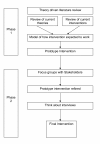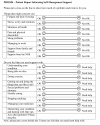An intervention to promote patient participation and self-management in long term conditions: development and feasibility testing
- PMID: 20630053
- PMCID: PMC2912900
- DOI: 10.1186/1472-6963-10-206
An intervention to promote patient participation and self-management in long term conditions: development and feasibility testing
Abstract
Background: There is worldwide interest in managing the global burden of long-term conditions. Current health policy places emphasis on self-management and supporting patient participation as ways of improving patient outcomes and reducing costs. However, achieving genuine participation is difficult. This paper describes the development of an intervention designed to promote participation in the consultation and facilitate self-management in long-term conditions. In line with current guidance on the development of complex interventions, our aim was to develop and refine the initial intervention using qualitative methods, prior to more formal evaluation.
Methods: We based the intervention on published evidence on effective ways of improving participation. The intervention was developed, piloted and evaluated using a range of qualitative methods. Firstly, focus groups with stakeholders (5 patients and 3 clinicians) were held to introduce the prototype and elucidate how it could be improved. Then individual 'think aloud' and qualitative interviews (n = 10) were used to explore how patients responded to and understood the form and provide further refinement.
Results: The literature highlighted that effective methods of increasing participation include the use of patient reported outcome measures and values clarification exercises. The intervention (called PRISMS) integrated these processes, using a structured form which required patients to identify problems, rate their magnitude and identify their priority. PRISMS was well received by patients and professionals. In the individual qualitative interviews the main themes that emerged from the data related to (a) the content of the PRISMS (b) the process of completing PRISMS and how it could be operationalised in practice and (c) the outcomes of completing PRISMS for the patient. A number of different functions of PRISMS were identified by patients including its use as an aide-memoire, to provide a focus to consultations, to give permission to discuss certain issues, and to provide greater tailoring for the patient.
Conclusions: There was evidence that patients found the PRISMS form acceptable and potentially useful. The challenge encountered by patients in completing PRISMS may encourage exploration of these issues within the consultation, complementing the more 'task focussed' aspects of consultations resulting from introduction of clinical guidelines and financial incentives. Further research is required to provide a rigorous assessment of the ability of tools like PRISMS to achieve genuine change in the process and outcome of consultations.
Figures
References
-
- Murray CJ, Lopez AD. The global burden of disease:a comprehensive assessment of mortality and disability from disease, injuries and risk factors in 1990. Boston: Havard School of Public Health on behalf of the World Bank; 1996.
-
- Department of Health. Supporting people with long term conditions: An NHS and Social Care Model to support local innovation and integration. London: Department of Health; 2005.
-
- Department of Health. The NHS Improvement Plan: Putting People at the Heart of Public Services. London. 2004.
Publication types
MeSH terms
Grants and funding
LinkOut - more resources
Full Text Sources
Medical





